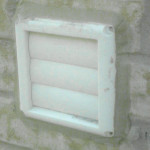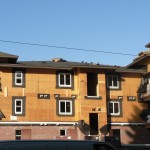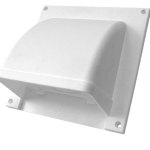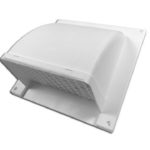
Great strides have been made in recent years in improving the energy efficiency of homes and buildings, but at a cost. Insulation has increased in walls and attics and has been added to crawlspaces. New fenestration standards, which minimize air leakage around windows and doors, have been introduced, although prices have increased due to manufacturing costs. Expensive high efficiency furnaces and heat pumps dramatically reduce the amount of energy used.
So, isn’t it ironic that many builders and installers use cheap, poor quality vents to cap off the large holes they need to cut for exhaust fans and dryers? These vents use what many people call ‘flappers’ as an attempt to prevent the entry of cold (or hot) air.
Whenever it is necessary to vent air to the outside of a building there is one main problem to overcome. Not only do air and fumes go out but they can also come back inside, something known as a back draft. This can negate much of the expense and effort made to improve a building’s energy efficiency.
The simple solution to this deficiency is a damper that will lift under slight pressure allowing the air to escape, but will close quickly and firmly preventing cold air and moisture from (re) entering the building. It must also resist being opened by breezes and wind from the outside and provide a barrier to the entry of birds, rodents and insects. Did you know these vents could become a favorite place for wasps to build nests?
Some of those cheap ‘flapper’ type vents include the louvered variety that use three or four horizontal slats. These open from the force of air coming out and rely on gravity to return them to a closed position, but lack a proper seal. They simply hang against the housing. Most often, this design has no screen.
Built out of cheap plastic and after exposure to the elements, these vents become brittle and break, or warp and jam open. Flimsy individual louvers are easily blown around or broken by the wind making an annoying rattling sound. This is also the case with similar designs that use a simple flap on the outside that dangles against the vent and opens thanks to gusts of wind.
It’s also hard to clean these designs. Grease from a range hood or lint from a clothes dryer can jam the flap open. Once these flappers are open there is nothing to stop the usual suspects from entering the home (cold air, moisture and pests), not to mention they look terrible!
Compare these flappers with a high quality alternative that uses an efficient damping system. Consider the cost of replacing broken flappers every few years, combined with the increased energy costs and the price difference becomes negligible.
Look for models that have optional screens and removable hoods for cleaning. These housings are made of one-piece plastic to prevent leaky seams and allow the damper to seal effectively. Oversize flanges accommodate water-tight installation.
Mounting the damper inside the vent protects it from damage and prevents noisy flapping from wind as well as better airflow. The high quality plastic and resins used are durable, UV resistant and will last for years. These types of vents are easy to remove and clean, which prevents clogging.
As you can see a slightly increased initial cost is more than made up by long-term benefits.



